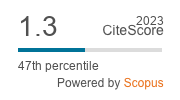Using Space Syntax For Estimation Of Potential Disaster Indirect Economic Losses
DOI:
https://doi.org/10.1515/cer-2016-0041Keywords:
space syntax methodology, indirect economics loosesAbstract
The paper is aimed at estimation of indirect economic losses resulting from natural disasters. Generally, these losses are defined as interruptions in economic activities and are not related to the damaged enterprises. Even limited physical damage to property and infrastructure caused by natural disaster can produce chain reaction of losses in supply chain within a certain region.
The Space Syntax Methodology is developed and used for accessing the characteristics of buildings, cities or the surrounding space in general. Although the methodology was primarily developed as urban planning method, it was also applied in the field of social and economic networks. Various studies of poverty, crime, disaster management and real estate prices are based on this methodology.
The economic activities within a specific area are in a state of equilibrium before a disastrous event occurs. The disaster will change the spatial configuration (streets, buildings and infrastructure) causing negative effect on the economic networks and business opportunities. The main assumption of the research is that potential indirect losses could be estimated by comparing the Space Syntax characteristics before and after a disastrous event by measuring the deterioration of links between economic enterprises.
The methodology is applied in a practical study of urban area. OpenStreetMap data is used as road-centred map of the city of York. The Historical Flood Map of the UK Environment Agency is used to setup disaster event impact. The Angular Segment Analysis implemented in DepthmapX software is used as the main method for analysis.
The study of applicable network measures shows that Normalised Angular Choice can be used as criteria for selecting alternatives for minimizing indirect costs caused by road network damages. At the same time, this methodology cannot be used for monetizing indirect costs or identifying losses in different economic sectors. The study approach does not contradict the main theoretical approaches and it gives new opportunities for research on disasters recovery.
Downloads
References
Al-Sayed K., Turner A., Hillier B., Iida S., Penn A. (2015), Space syntax methodology textbook, Bartlett School of Architecture, UCL, London.
Google Scholar
Batty M. (2004), A new theory of space syntax, Working Paper 75, Centre for Advanced Spatial Analysis, University College London.
Google Scholar
Castillo M.M. (2013), Urban Patterns And Disaster Risk, [in:] Proceedings of the Ninth International Space Syntax Symposium, (ed.) Y. O. Kim, H. T. Park and K. W. Seo, Seoul: Sejong University.
Google Scholar
Clower T.L. (2005), Economic applications in disaster research, mitigation, and planning, ʻDisciplines, Disasters and Emergency Management: The Convergence of Concepts Issues and Trends From the Research Literatureʼ.
Google Scholar
Cutini V., Petri M., Santucci A. (2004), From axial maps to mark point parameter analysis – a GIS implemented method to automate configurational analysis [in:] Computational science and its applications – ICCSA 2004: International conference, Assisi, Italy, may 14–17, part II.
Google Scholar
Dalton N. (2001), Fractional configurational analysis and a solution to the Manhattan problem [in:] Space Syntax 3rd International Symposium, Atlanta.
Google Scholar
Data.gov.uk, Historic Flood Map – Datasets.
Google Scholar
David S., Brookshire J.T., Mark A. Thayer (1985), A test of the expected utility model: Evidence from earthquake risks, ʻJournal of Political Economyʼ, vol. 93, no. 2.
Google Scholar
De Groeve T. et al. (2015), Guidance for recording and sharing disaster damage and loss data towards the development of operational indicators to translate the Sendai Framework into action., Publications Office, Luxembourg.
Google Scholar
Don N., MacDonald H.L.W., James C. Murdoch (1987), Uncertain hazards, insurance, and consumer choice: Evidence from housing markets, ʻLand Economicsʼ, vol. 63, no. 4.
Google Scholar
FEMA (2015), Estimating Potential Losses From Disasters [in:] FEMA Fact Sheet.
Google Scholar
FEMA (2014), HAZUS-MH, User Manual: Multi-hazard Loss Estimation Methodology, Flood Model, FEMA.
Google Scholar
Gil J., Steinbach P. (2008), From flood risk to indirect flood impact: Evaluation of street network performance for effective management, response and repair [in:] WIT Press, WIT Press, vol. I.
Google Scholar
Grubesic T.H., Murray A.T. (2008), Vital nodes, interconnected infrastructures, and the geographies of network survivability, ʻAnnals of the Association of American Geographersʼ, vol. 96, no. 1.
Google Scholar
Hillier B., Hanson J. (1984), The social logic of space, Cambridge University Press, Cambridge University Press.
Google Scholar
Hillier W.R.G., Yang T., Turner A. (2012), Normalising least angle choice in Depthmap-and how it opens up new perspectives on the global and local analysis of city space, ʻJournal of Space syntaxʼ, vol. 3, no. 2.
Google Scholar
Jiang B., Claramunt C. (2004), Topological Analysis of Urban Street Networks, ʻEnvironment and Planning B: Planning and Designʼ, vol. 31, no. 1.
Google Scholar
Koks E.E. et al., (2015), Regional disaster impact analysis: Comparing Input-Output and Computable General Equilibrium models, ʻNatural Hazards and Earth System Sciences Discussionsʼ, vol. 3, no. 11.
Google Scholar
OECD (2012), Disaster Risk Assessment and Risk Financing. A G20 / OECD Methodological Framework, OECD.
Google Scholar
Sakakibara H., Kajitani Y., Okada N. (2004), Road network robustness for avoiding functional isolation in disasters, ʻJournal of Transportation Engineeringʼ, vol. 130, no. 5.
Google Scholar
Schulz C. (2012), The identification of critical road infrastructures – the case of Baden-Württemberg, KIT Scientific Publishing, Karlsruhe.
Google Scholar
Turner A. (2005), Could a road-centre line be an axial line in disguise [in:] Proceedings of the 5rd Space Syntax Symposium, vol. 1.
Google Scholar
Downloads
Published
How to Cite
Issue
Section
License

This work is licensed under a Creative Commons Attribution-NonCommercial-NoDerivatives 4.0 International License.











